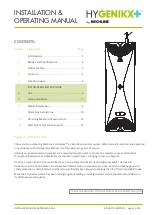
Air & Surface Steriliser System
INSTALLATION & OPERATING MANUAL REVISION: 04/2020 | page 13 of 16
Titanium dioxide is also a semiconductor. When a semiconductor is bombarded with light of certain wavelengths,
electrons in the material’s valence band are excited into the conduction band. This means they are free to move
and their energy ends up splitting nearby water molecules into two parts, hydroxyl radicals and super-oxide ions.
Free radicals are uncharged atoms or molecules with unpaired electrons. Unpaired electrons are highly reactive,
so free radicals quickly engage in chemical reactions. Hydroxyl radicals are among the most powerful oxidizers in
the world, stronger than chlorine, ozone, and peroxide, and also very short lived.
Superoxide is created by the addition of one electron to oxygen. This free radical has a relatively long half-life:
less than one second.
Bacteria, viruses and volatile organic compounds (VOCs), are held together by carbon-carbon, carbon-oxygen or
carbon-hydrogen bonds. Oxidizers destroy these bonds and fragment the molecule into smaller compounds
which are broken down until only carbon dioxide and water are left.
A photocatalytic purifier can eliminate particles down to 0.001 microns from air, including the very tiny lung
penetrating particles. Most HEPA air filters cannot remove particles smaller than 0.3 microns.
Pollens, dust mite allergens, pet dander, mould, bacteria, and viruses in the air, are on the list of items removed
through Photocatalytic reaction. HyGenikx, incorporating this technology, can eliminate toxic gas VOC pollutants
including formaldehyde, exhaust fumes, benzene, toluene, and odours like ammonia and hydrogen sulphide
from our air.
•
Germicidal Irradiation by dual UV light (Ultraviolet) kills microorganisms (bacteria, viruses and mould) by
disrupting their DNA and removing their reproductive capabilities.
•
PCO – Photocatalytic Oxidation, UV reacts with our Catalyst (Ti02 Titanium Dioxide) to form highly reactive
but short lived oxidising Hydroxyl Radicals (OH) which break down Volatile Organic Compounds (VOCs).
•
Interaction of the Dual waveband UV with the TiO2 heterogeneous catalyst both creates and breaks down
Oxygen molecules transforming Oxygen into a highly reactive states of Ozone and Superoxide Ions which
leave the unit as “Plasma Quatro”.
•
Plasma Quatro is the gas energized by the high intensity UV light. It leaves the unit with the airflow and
consists of a mixture of activated oxygen, triatomic oxygen and superoxide ions. These interact with each
other giving a very efficient purification of the air and all exposed surfaces. Many times more efficient than
ozone or UV light working alone.
9.4.9 The unit produces ozone. Is this dangerous?
Whilst HyGenikx is not an ozone generator, a very small volume of ozone is released as a by-product of the
combination of technologies used. This unique combination of technologies is guaranteed to both achieve results
and be completely safe in operation. In every case the ozone levels present fall well below the lowest
international safety levels worldwide (World Health Organization - 0.05ppm), as stipulated by EUOTA. This has
been verified for all unit variations with independent laboratory testing carried out by “Odournet”.
We all breathe ozone, every day of our life, in fact what we perceive to be fresh air is approximately 0.013ppm
of ozone.
If there was a thunderstorm nature would produce between 0.3/0.05ppm which gives us that nice fresh smell
that follows.
Ozone (O3) is a form of oxygen. It is a colourless gas with a distinctive odour and is a normal constituent of the
earth’s atmosphere. It is about 1.6 times heavier than air (density 2.144 g/I). Ozone is produced naturally from
oxygen whenever sufficient ultraviolet (UV) radiation or electrical discharges occur, for example at high altitudes
or by the action of lightning. Such natural occurrences are unlikely to produce hazardous concentrations at
ground level. The majority of ozone found near ground level is formed by photochemical reactions involving
oxides of nitrogen and hydrocarbons.
HSE UK - COSHH – For areas of Continuous occupation – HSE limit 0.1ppm
World Health Organization – Continuous occupation desired level – 0.05ppm
Questions and Answers continued overleaf…
















